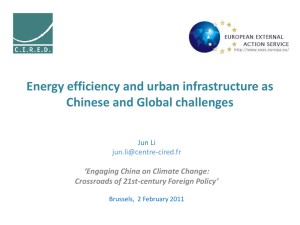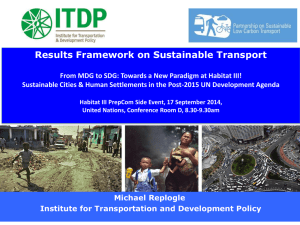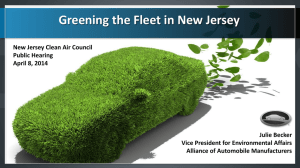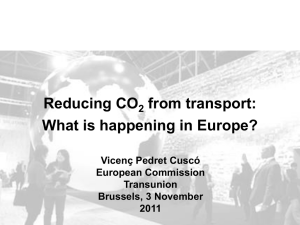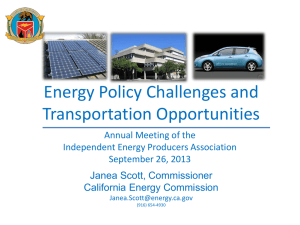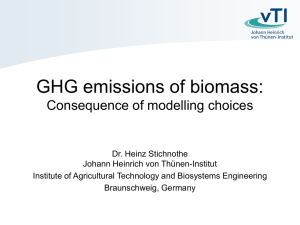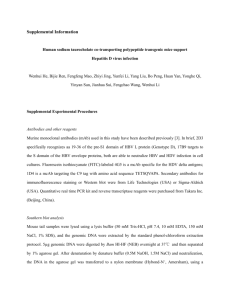Gordon Slides - Carnegie Endowment for International Peace
advertisement
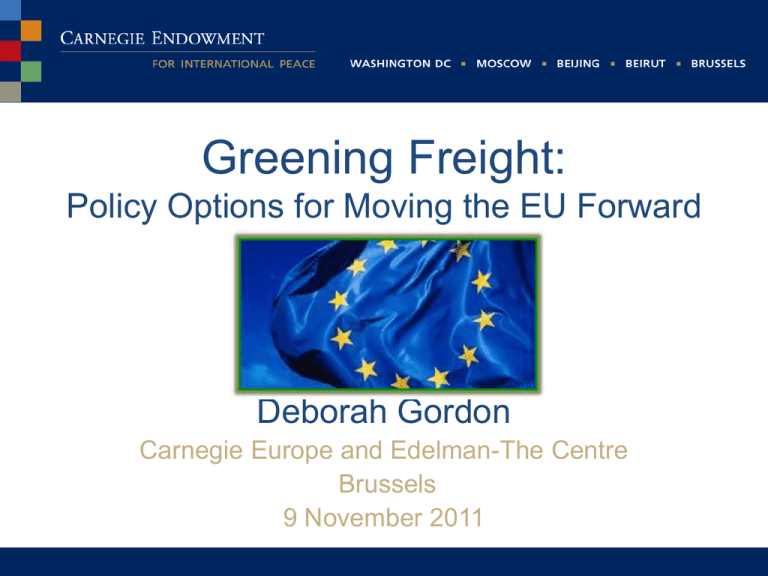
Greening Freight: Policy Options for Moving the EU Forward Deborah Gordon Carnegie Europe and Edelman-The Centre Brussels 9 November 2011 Heavy-Duty Truck Roadmap • Business-as-usual freight transport o Growing truck dominance o Growing diesel demand o Growing climate burdens • Public policy prescriptions Protect public health Reduce climate forcing Enhance energy and economic security y EU Energy and Economic Security Issues Related to HDVs • Reduce dependence on dwindling diesel supplies and oil imports • Protect against unstable global oil markets • Maintain EU competitiveness through production of future fuel-efficient HDVs • Avoid possible off-loading of high-C HDVs from makers in nations with GHG standards Source: European Commission, European Energy and Transport Trends to 2030 (2008) EU Climate Security Issues Related to HDVs • EU to reduce emissions by 8095% below 1990 levels by 2050 • Growing GHGs in transport sector requires a 60% reduction by 2050 (with respect to 1990) • By 2030, the goal for transport will be to reduce GHG emissions to around 20% below their 2008 level Source: European Commission, European Energy and Transport Trends to 2030 Current EU Freight Situation 1. Trucks haul 70+% EU freight 2. The EU HDV market is dominated by 7 major manufacturers (accounting for 93% of EU registrations) – – – – – – – DAF (Netherlands) Daimler AG (Germany) M.A.N. (Germany) Renault (France) Scandia (Sweden) Volvo (Sweden) Iveco (Italy) 3. Major EU HDV manufacturers account for an estimated 40% of worldwide HDV production 4. The majority of freight operators are small in size, with 85% having fewer than 10 vehicles 5. Major shipping companies determine which technologies enter the marketplace by closely watching fuel use, fuel price, and driving patterns EU Freight Business-as-usual Trends • 31% more HDVs by 2030 • 27% more HDV travel by 2030 • HDV fuel economy could deteriorate by ~3% annually due to Euro VI (2013) Source: European Commission, European Energy and Transport Trends to 2030 (2008) Growing HDT Diesel Demands • Long-haul trucks account for 37% diesel use in 2010 • HDV diesel use projected to increase 21% by 2030 Source: European Commission, European Energy and Transport Trends to 2030 (2008) Increasing HDT CO2 Emissions • Trucks account for 85% all freight CO2 (2010) • Long-haul trucks account for 39% of the 2030 emissions; fuel saving potential is the greatest of all categories • HDV CO2 emissions increase in BAU of 15% from 2010 to 2030 EU Existing and Planned HDV-related Policies • Conventional pollutant emission standards Short-term climate forcing Balancing dual objectives (air quality/climate) • Driver training Reduce in-use GHGs Greater reduction when paired with GHG standards • HDV road fees Indirect GHG benefit • GHG emission standards Standards in progress Component efficiencies (tyres) Source: AEA, Report to the European Commission, “Reduction and Testing of GHG Emissions from Heavy Duty Vehicles,” February 2011. HDV Policies at EU Member State Level • EU HDV GHG standards should not be left to individual states National variability too great Long-haul and regional delivery vehicles present greatest opportunity for GHG emission reduction • State policies, especially fiscal, can support EU HDV GHG standards Reduce in-use GHGs Source: AEA, Report to the European Commission, “Reduction and Testing of GHG Emissions from Heavy Duty Vehicles,” February 2011. A Way Forward: HDV GHG Reduction Potential HDV Technology Potential Improvement in Fuel Consumption (U.S.) 60% Aero Weight Transmission Mgmt & Coaching 50% Engine Tires & Wheels Hybrid Fuel consumption reduction potential 35% – 50% FC Benefit 40% U.S. Comparison of 2015-2020 New Vehicle Potential Fuel Savings Technology for Seven Vehicle Types: Tractor Trailer (TT), Class 3-6 Box (Box), Class 3-6 Bucket (Bucket), Class 8 Refuse (Refuse), Transit Bus (Bus), Motor Coach (Coach), and Class 2b Pickups and Vans (2b). 30% 20% 10% 0% TT Box Bucket Refuse Bus Coach 2b SOURCES: ICCT, Moving the World, December 1, 2010; TIAX (2009) at ES-4 Technologies Improve HDV Performance • Technologies in the drivetrain and vehicle categories can have a large impact on fuel consumption Hybridisation, dual fuel, lightweighting, automatic tire pressure, automated transmission, aerodynamics, low rolling resistance tyres, heat recovery,……… • For vehicles with an urban duty cycle with frequent stop / start operation, hybrid vehicles offer the highest benefit: savings of between 20% and 30% • For HDVs on long-haul aerodynamic aids (e.g. trailers) offer benefits: 10% reduction (and more) PolicyStep: landscape: Across Regions Next EUTimelines Set HDV GHG Standards Global Snapshot of Heavy-Duty Vehicle GHG and Fuel Economy Standards Note: Text in red indicates expected, not actual Frameworks Paving the Way on HDV GHG Regulatory Design 14 Policy Options to Reduce HDV CO2 Emissions Direct Policies • Performance (GHG) Standards for HDVs • Guaranteed timeline • Technology forcing • Requires enforcement • Fuel Taxes • Variable responsiveness • Must be indexed to inflation • Self enforcing Indirect/Supporting Policies • • • • • • Emissions trading Labeling HDVs Speed limits on HDVs Driver training Road user charges Differentiated vehicle purchase taxes/incentives Thank you Deborah Gordon Senior Associate Carnegie Endowment for International Peace Energy & Climate Program Washington, DC http://www.carnegieendowment.org/programs/ Program Stringency Summary for ModelHDV Year 2017 U.S. Standards for Improved Performance Largest reductions in the vehicle categories that use the most fuel U.S. Standards (MY 2017): Largest Reductions in HDV Categories HDV Technology Compendium
